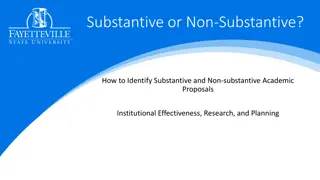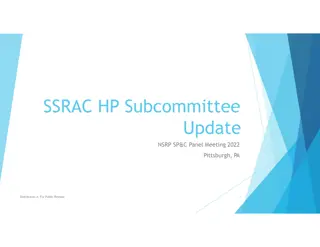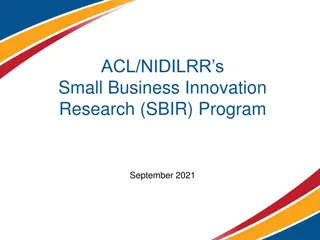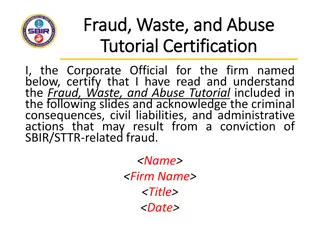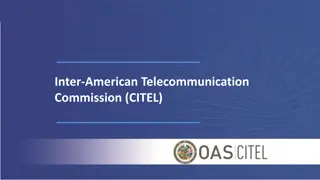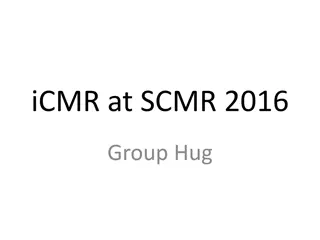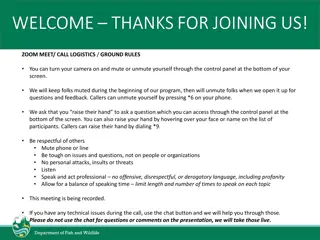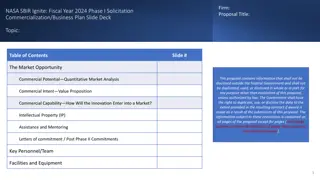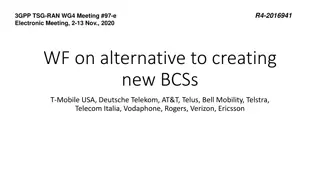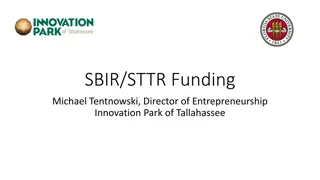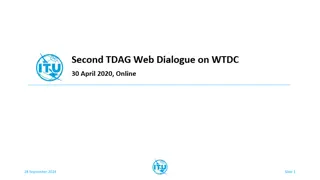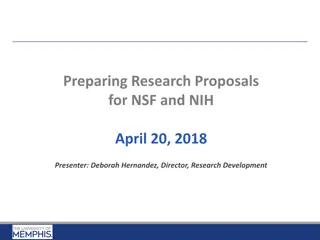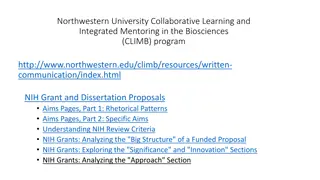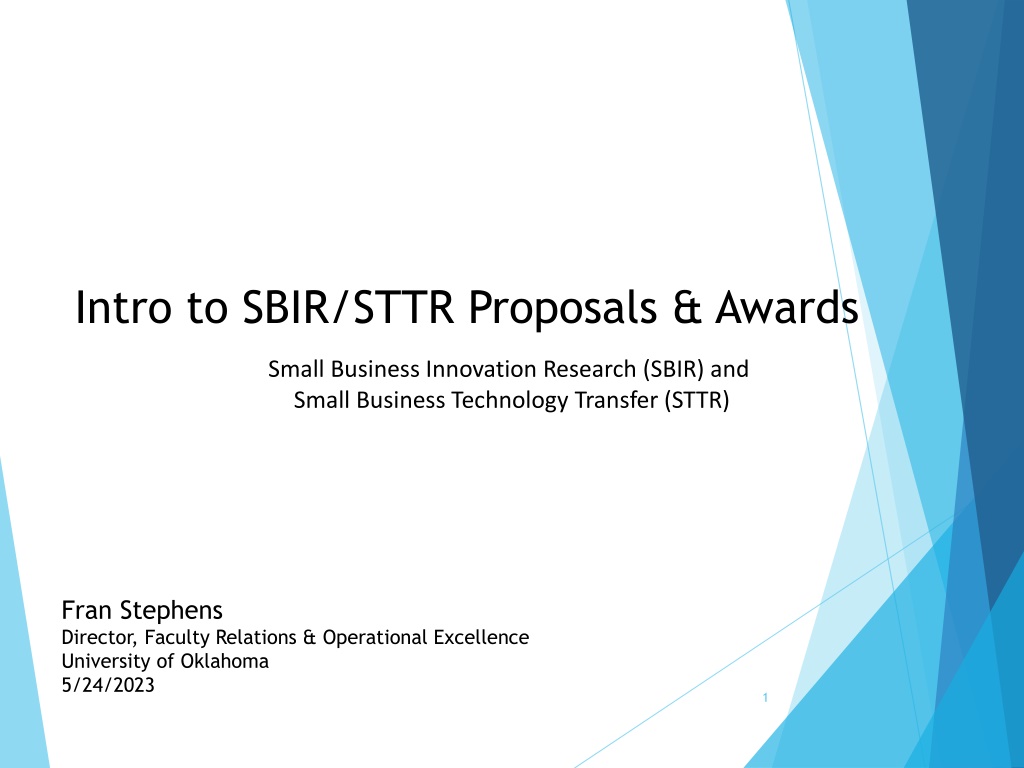
SBIR STTR Proposals and Awards Overview
Learn about the Small Business Innovation Research (SBIR) and Small Business Technology Transfer (STTR) programs, their objectives, cautions, and phases. Understand the role of the Small Business Administration (SBA) in overseeing federal agency programs and accessing resources. Discover how these research projects benefit both small businesses and federal agencies while fostering innovation and commercialization.
Uploaded on | 0 Views
Download Presentation

Please find below an Image/Link to download the presentation.
The content on the website is provided AS IS for your information and personal use only. It may not be sold, licensed, or shared on other websites without obtaining consent from the author. If you encounter any issues during the download, it is possible that the publisher has removed the file from their server.
You are allowed to download the files provided on this website for personal or commercial use, subject to the condition that they are used lawfully. All files are the property of their respective owners.
The content on the website is provided AS IS for your information and personal use only. It may not be sold, licensed, or shared on other websites without obtaining consent from the author.
E N D
Presentation Transcript
Intro to SBIR/STTR Proposals & Awards Small Business Innovation Research (SBIR) and Small Business Technology Transfer (STTR) Fran Stephens Director, Faculty Relations & Operational Excellence University of Oklahoma 5/24/2023 1
Intro to SBIR/STTR Proposals Objectives Learn basic information about the SBIR and STTR programs. Describe some of the cautions to be aware of related to companies involved in SBIR and STTR projects. 2
Intro to SBIR/STTR Proposals Small Business Innovation Research (SBIR) and Small Business Technology Transfer (STTR) are research projects that have potential for commercial impact and benefit the research goals of the federal agency. Projects may require a business and a non-profit research university to partner on the work involved. 3
Intro to SBIR/STTR Proposals The Small Business Administration (SBA) oversees and coordinates all the federal agencies that have SBIR/STTR programs and can approve solicitation budgets outside of the normal parameters. Note that they also call these programs America s Seed Fund . The SBA also runs www.SBIR.gov which has links to federal agencies involved, lists opportunities, has state contacts for information and assistance, and has tutorials on various aspects of the programs and things to consider such as Intellectual Property. (The ppt Leveraging America s Seed Fund is a good overview of resources; Oklahoma does have state contacts and programs.) Currently twelve federal agencies have SBIR funding and five have STTR funding (see the list on the SBIR website). Investigate their websites. Some have one office that manages all SBIR/STTR types of proposals, and some have each division/directorate manage their own. Most provide funding announcements and contact information. Some are very robust and do webinars, conferences, provide post award info, and help match research organizations and companies. 4
Intro to SBIR/STTR Proposals From SBR.gov 5
Intro to SBIR/STTR Proposals The Three Phases of SBIR/STTR Phase I. The objective of Phase I is to establish the technical merit, feasibility, and commercial potential of the proposed R/R&D efforts and to determine the quality of performance of the small business awardee organization prior to providing further Federal support in Phase II. SBIR/STTR Phase I awards are generally $50,000 - $250,000 for 6 months (SBIR) or 1 year (STTR). Phase II. The objective of Phase II is to continue the R/R&D efforts initiated in Phase I. Funding is based on the results achieved in Phase I and the scientific and technical merit and commercial potential of the project proposed in Phase II. Typically, only Phase I awardees are eligible for a Phase II award. SBIR/STTR Phase II awards are generally $750,000 for 2 years. Phase III. The objective of Phase III, where appropriate, is for the small business to pursue commercialization objectives resulting from the Phase I/II R/R&D activities. The SBIR/STTR programs do not fund Phase III. At some Federal agencies, Phase III may involve follow-on non- SBIR/STTR funded R&D or production contracts for products, processes or services intended for use by the U.S. Government. 6 From SBR.gov
Intro to SBIR/STTR Proposals STTR differs from SBIR in three important aspects: 1. The small business awardee and its partnering institution are required to establish an intellectual property agreement detailing the allocation of intellectual property rights and rights to carry out follow-on research, development or commercialization activities. 2. STTR requires that the small business perform at least 40% of the R&D and a single partnering research institution perform at least 30% of the R&D. 3. The STTR program allows the Principal Investigator to be primarily employed by the partnering research institution. 7
Intro to SBIR/STTR Proposals From SBR.gov 8
Intro to SBIR/STTR Proposals Company involved in an SBIR/STTR must: Must be for profit. US owned and operated. Less than 500 employees. 9
Intro to SBIR/STTR Proposals For STTR, the partnering nonprofit research institution must also meet certain eligibility criteria: Located in the US Meet one of three definitions: Nonprofit college or university Domestic nonprofit research organization Federally funded R&D center (FFRDC) 10
Intro to SBIR/STTR Proposals Submitting SBIR/STTR proposals: Exact contents of the submission package and the submission system will vary by the sponsor so read the guidelines closely. If copies of legal agreements or special certifications are needed start the process early (work with ORS). Info sheet is required at preliminary submissions regardless if OU is lead or subcontract. If OU is the lead we will need subcontract paperwork from the company; if an FFRDC is involved we ll need the appropriate package from them. Check guidelines for special or unusual requirements such as ND agreements being included with submission. If the company is the lead you will need to provide them a subcontract package (SOW, budget, budget justification, letter from ORS). Depending on sponsor requirements other paperwork may be needed. 11
Intro to SBIR/STTR Proposals Cautions Many times a PI may create a company, have fiscal or relationship ties with one, or may want to involve a company of a colleague. The company must be an official entity (registered in SAM.gov, have a Unique Entity Identifier, have a tax ID number). The company must have or establish accounting systems that will allow them to track and report expenditures and if they are the primary also accomplish needed reports and grant/contract management. Audit flags: Company address is home address Using an email address or phone number of another entity for official communications (for example using an OU email address instead of a company address when doing business as/for the company) 12
Intro to SBIR/STTR Proposals Cautions You cannot have the same PI at the company and at the educational institution. OU assets cannot be used for accomplishing the company s objectives for free. The company may want some type of Intellectual Property agreement or Non Disclosure agreement at proposal state and/or at award stage. These need to be approved by OU s Office of Technology and Commercialization and Legal offices. Some solicitations require a copy of agreements to be submitted with the proposal. 13
Intro to SBIR/STTR Proposals Cautions Conflict of Interest If an OU PI has a fiscal or relationship conflict with a company involved in a proposal submission it must be disclosed. Fiscal could involve honoraria or other payments. Relational could mean involvement in company creation, management, consulting/advising, or familial ties. Disclosure is through the normal OU conflict of interest process Conflict of Interest (ou.edu) Because of issues seen with SBIR/STTR proposals an awards specific guidance has been established at OU SBIR STTR Projects (ou.edu) Note: If an OU PI/CoPI discloses a COI with a company, the company should also have an established COI process and disclose the conflict too. (This would be an expectation for an entity that is set up to do business With the federal agencies.) 14
Intro to SBIR/STTR Proposals Take-a-Way Highly competitive programs. Federal agencies with extramural Research and Development budgets over 100M are required to fund a certain percentage of SBIR/STTR proposals. (percent varies by budget amount) Make sure any company involved is officially established as an entity that can do business with the government. If the PI has any type of fiscal or relationship involvement with an involved company be sure to disclose it on the information sheet. If a relationship develops later in the proposal or award process let ORS know as soon as possible. Investigate the sponsor website for SBIR/STTR information. 15
Intro to SBIR/STTR Proposals Contacts for Information and Questions Fran Stephens, Director, Faculty Relations & Operational Excellence fran@ou.edu Cindy Clark, Assistant Director of Research Information Services ris@ou.edu 16




